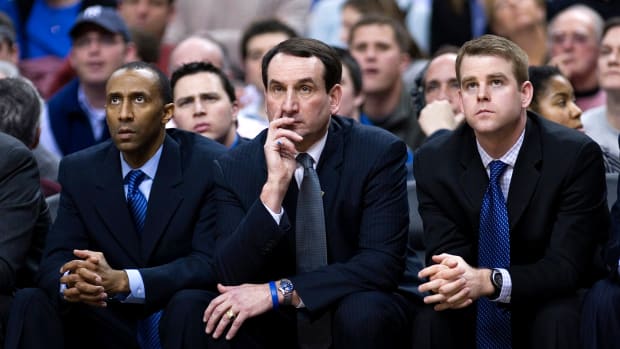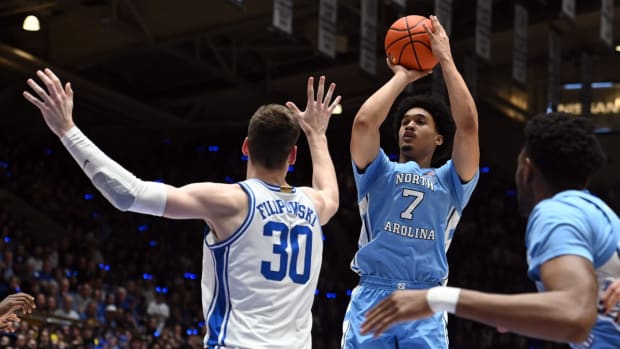Key Play Breakdown: SFA's Final Shot Beats Duke
The clip has been retweeted hundreds of times. It’s been set to the music from Titanic.
As the world revels in Duke’s home court loss to Stephen F. Austin, on a buzzer beating fast break layup, let’s take a look at what the Blue Devils will undoubtedly be watching over and over during a Thanksgiving hell week of practice.
The set up: Duke had the ball in a tie game with a 10 second difference between shot and game clocks. Tre Jones took a jumper with 16 seconds left and missed, but Wendell Moore managed to get the rebound.
Without calling timeout, Duke scrambles to reset its offense. It has three men outside the three point line—Wendell Moore in the left corner, Jack White at the left wing, Cassius Stanley in the right corner.
Tre Jones can drive and kick to any of them of pass to Matthew Hurt at the basket.
Where was Vernon Carey, you might ask. He was on the bench. Coach K had been playing offense/defense, subbing him for Jack White, but when Matthew Hurt blocked Cameron Johnson’s layup attempt at the 42 second mark, Duke opted not to call time out to get Carey back in, which would have allowed SFA to set up its defense.
As Jones begins his drive, White is waving Moore to get deeper into the corner. The defenders are sagging off of that side of the floor to crowd the middle, and Moore would be wide open for a baseline three if Jones kicks.
The pass: Jones throws a bounce pass to Hurt, who is on the lower block. It looks like a good decision. Gavin Kensmil (14) is cheating off of Moore but still needs to scramble to get in front of Hurt. Roti Ware (2) had stepped up to defend the drive and is also scrambling to get back onto Hurt. He’ll have the chance to get off a quick shot as two guys are diving at him.
Except the ball bounces off of his hands.
SFA reacts immediately. Ware dives to the floor at Hurt’s feet, keeping him from getting down on the loose ball. Kensmil also dives. There are two SFA players on the floor and no Blue Devils, as Coach K will undoubtedly point out multiple times.

Moore (0) wide open on the other side of the paint. The other three players on both teams stand and watch from a distance.
Moore, who has rushed in from the corner, is open on the other side of the basket. If Hurt gets the ball, a quick pass will give him an open game-winning layup. By the time he realizes Hurt isn’t getting the ball, it’s too late for him to get on the floor to tie Kensmil up.
Moore dives anyway, which likely kept him from having any chance of running down the breakaway layup.
Meanwhile, on the perimeter, White, Jones and SFA’s Nathan Bain are standing flat footed, watching the action. Kensmil gets the loose ball and passes to Bain while sitting on the floor.
Jones and White both charge at him to try to strip the ball, which has them going in the wrong direction if Bain gets by them, which he does.
White heads up floor at full speed, but Jones, who played all 45 minutes, pulls up and stops. On the other side, Cassius Stanley was jogging half-speed before realizing what was happening and throwing it into gear.
They’re all too late. Bain pulls away. White chases in vain. The other two are barely in the picture as the game winner drops through and the horn sounds
There were plenty of reasons why Duke lost--turnovers, points in the paint, effort and discipline. All of them came into play on the highlight-film game winning shot.











